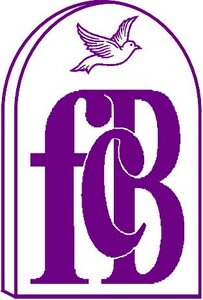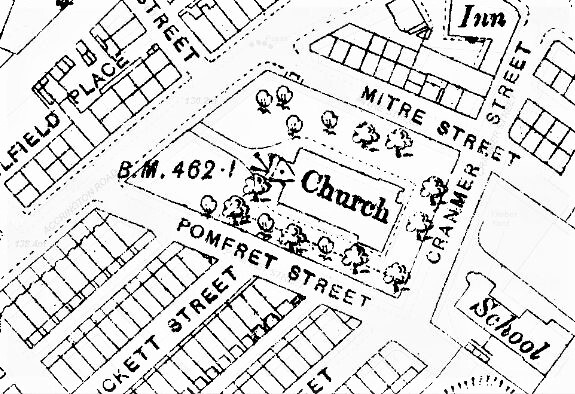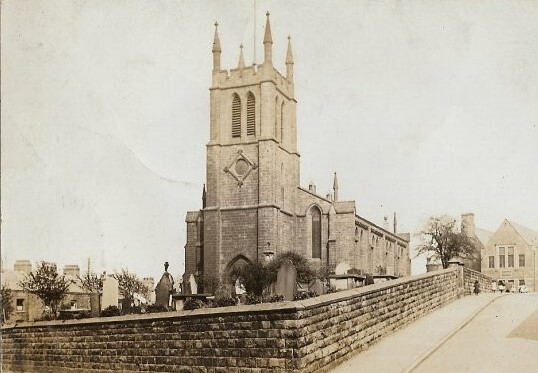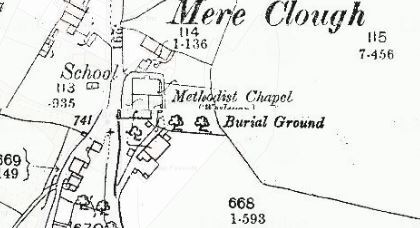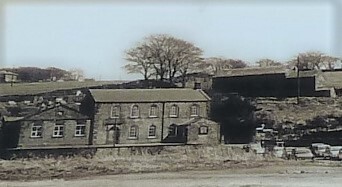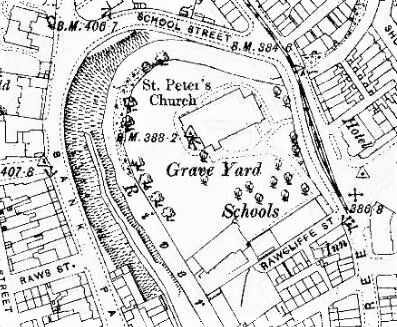All Saints and St. John the Baptist Graveyard, Padiham Road, Burnley
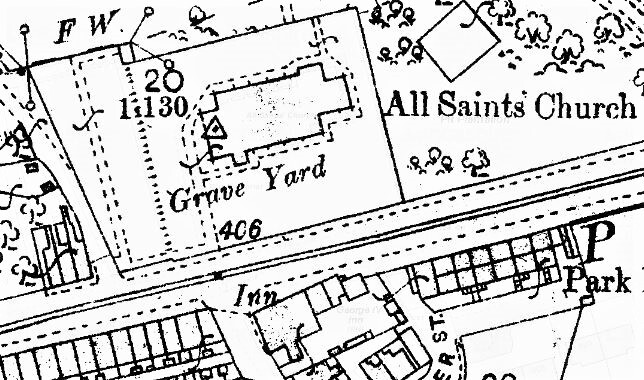
1890's OS Map showing the church, surrounding graveyard and the 1887 extension to the west
In June1885 the churchyard was officially closed for new burials except those in family vaults or existing walled graves. At this time, the churchyard being full for some time, Sir Ughtred Kay-Shuttleworth had offered a 27sq.m. piece of ground lying to the west of the older portion as an extension to the burial area. In July 1886 consent was given by the Home Office Burials Department to use this land. After the work of pulling down the existing west wall of the original churchyard and enclosing and draining the new land had been carried out, it was consecrated by the (then) Bishop of Manchester, the Right Rev. Dr. Moorhouse on 28th April 1887. The Parish Register shows 2,997 Burial Records for this Church.
Holy Trinity Burial Ground, Accrington Road, Burnley
Holy Trinity Church, designed by Lewis Vulliamy, was built at a cost of £2918 in 1835-1836. At that time Parliament had set aside a grant of £1.5 million for the building of new churches and the cost of building Holy Trinity came from that fund. It was consecrated by Bishop Sumner, the Lord Bishop of Chester, on 10th November 1836. The graveyard surrounds the church and, according to the Parish Register, the first burial on 15th March 1837 was that of a child aged 1yrs 5 weeks from Blackburn Road, Habergham Eaves.
1890's OS Map showing the church and surrounding graveyard.
The graveyard was closed in 1965 and the headstones preserved by being placed around the perimeter of the church. The Parish Register shows 1,590 Burial Records for this Church. The church, which is a Statutory Listed Building Grade II, was closed in 1989 and converted into flats in 1993.
Holy Trinity Church showing gravestones, date unknown
Mereclough Burial Ground, off Long Causeway, Cliviger
The Chapel was built in 1824 on a steeply sloping site with the graveyard sited on the higher ground to the east (now with separate access via a footpath from the Long Causeway). The chapel was closed and demolished in 1966 but the graveyard remains. A memorial garden was created on the site of the chapel in 1973.
There are 58 headstones in the graveyard dating from 1824 to 1966 which are arranged in rows.
1890's OS Map of the chapel and burial ground to the east
Mereclough Chapel about 1950
St. Peter's Graveyard, Church Street, Burnley
St. Peter’s is Burnley’s ancient parish church. Thought to have been built between the 8th century and 1122 it formed the centre of medieval Burnley. Most of the church was rebuilt in 1533 and further additions made 1789, 1802-3, 1854, 1872, 1889 and 1903. The graveyard surrounds the church and the first recorded burial in the Parish Register is that of a child of William Foulds on 15 April 1562. The graveyard was extended in 1807 when land was bought from the Towneley family. At that time the churchyard was enclosed to prevent vandalism. Most of the headstones date from the late 1700’s to the mid 1800’s.
1890's OS Map of the church and grave yard
The graveyard was closed for burials in June 1855 with the exception of private vaults. In the 1970’s churchyard improvements were carried out and two paths were made to the west of the church using head stones. During restoration work to the church in 1993 several gravestones were discovered under the wooden floor and these are now in the churchyard to the rear (north) of the church. The Parish Register shows 35,934 Burial Records for this Church.
